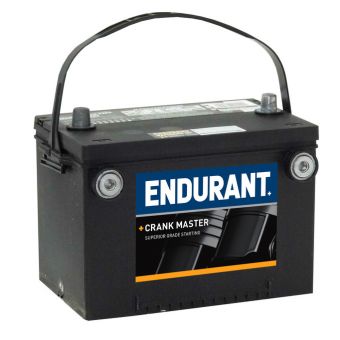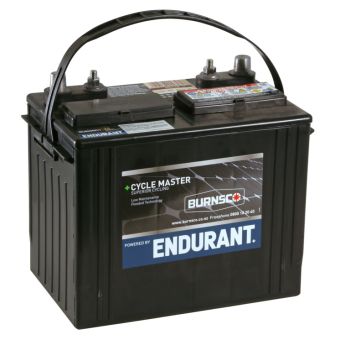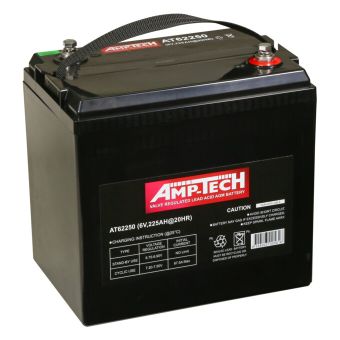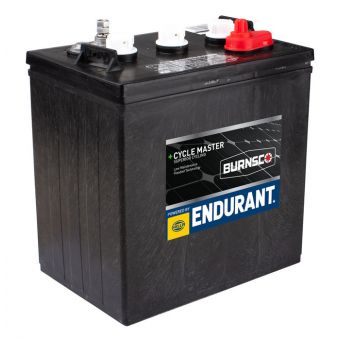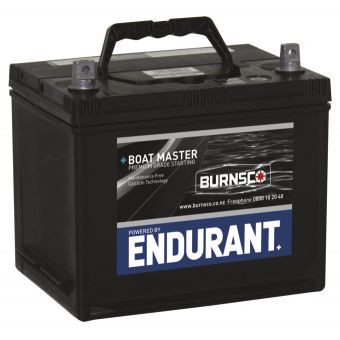Why Do I Need an Auxiliary Battery?
It can be a struggle to go a few days without electrical devices at our fingertips. An auxiliary battery allows you to power these devices anywhere, any time. Having the ability to run lights, a fan, or even keep beers cold for days in a fridge certainly does improve the quality of any trip. Secondary batteries, when wired correctly, also prevent unnecessary drain on the main/starting battery.
What Types of Battery are There?
The reason there are so many types of battery to choose from is because they are all designed to perform a specific task. While the construction of common battery types is very similar (they are all variations of a lead-acid battery), using the right battery in the right situation will save you money and protect you from harm!
There are two variations of battery known as ‘serviceable’ and ‘maintenance free’. Serviceable batteries have removable caps so the electrolyte levels can be checked and refilled regularly. They are not sealed as they need to vent the gases created when charging. Maintenance free batteries are completely sealed units and require no maintenance (other than proper charging and cycling). They don’t produce excess gas when charging and usually have a built-in hydrometer giving an indication of a cell's charge level.
Serviceable batteries are usually referred to as standard lead-acid batteries. Common types of maintenance free batteries are Calcium, AGM or Gel.
Why Cant I Just Use a Car Battery?
Charging batteries of this type causes the release of harmful and explosive gases. These gases build up quickly in a confined space, inhaling them is extremely dangerous and in some instances fatal. A small spark from a cooker or lighter can also ignite the gases. These batteries must be vented well at all times.
LEAD-ACID BATTERIES SHOULD NEVER BE USED INSIDE A BOAT OR MOTORHOME!
Here’s a breakdown of the most common auxiliary battery types used in RV and marine electrical systems along with their pros and cons:
- Calcium
- AGM and Gel
- Litium Ion or LiFePO4
Calcium Batteries
Calcium batteries are still a form of lead-acid battery, but they are sealed and maintenance free. With calcium added to the cells, the battery produces less gas, uses less water and has a higher resistance to corrosion, all while remaining cost effective. To keep these batteries healthy, they require a higher charging voltage compared to conventional batteries - a charger with a specific Calcium setting is usually needed to get the most life out of the battery.
AGM and Gel Batteries
AGM and Gel batteries are the next step up in maintenance-free battery technology. They are slightly more costly than calcium types but perform much better for motorhome and marine applications. AGM and Gel batteries are completely sealed and release no gas. This means they can be installed in an enclosed space and at any orientation/angle. These batteries are also designed to be repeatedly cycled (discharged and recharged), which is why they are commonly referred to as ‘deep cycle’ batteries.
These deep cycle batteries are usually rated according to the amount of power (amps) they can hold.
Never drain a deep cycle battery lower than 50% of its total capacity. Regularly discharging the battery to low levels will reduce its life significantly!
Therefore, a 100AH AGM battery actually has 50AH of usable power.
One downside to AGM or Gel batteries is that they don't like to be exposed to heat. As with calcium batteries, AGM and Gel types also require precise charging to get the most out of them. Most smart battery chargers will have a setting that ensures the voltage levels are correct for the several stages of charging.
Lithium Ion or LiFePO4 Batteries
These are the latest and greatest when it comes to the world of leisure batteries. They solve the main issues that all batteries above have in common: they are all heavy, take up a lot of space, and only half of their capacity is actually usable.
Lithium batteries are extremely lightweight and compact compared to their predecessors. They use lightweight lithium and carbon electrodes instead of bulky lead ones. This allows them to have a high electrical density in a more compact package. When every square inch of space counts, halving the space required for batteries by using Lithium over AGM is a real game changer.
While physically smaller, the lithium equivalent battery has nearly double the useable capacity of an AGM. This is because they have a staggering 90%+ depth of discharge (DOD). They can be repeatedly charged and nearly completely drained without harming long-term performance.
100AH Lithium battery has 90+AH of useable power
Lithium batteries generally have a built-in Battery Management System (BMS) - this closely monitors and controls each cell within the battery, utilising the power efficiently and safely. They also act as an extra failsafe with the ability to disconnect the battery should an internal issue occur. Like with AGM’s, Lithium batteries require specific charging voltages that ensure they have a long service life. Not all solar controllers, DC-DC chargers and 240V battery chargers have a lithium charging profile, so if you’re looking at upgrading an existing system, you may need to replace more than just the batteries.
How Do I Connect Two or More Batteries?
There are two different ways to connect batteries together, each with their own benefits in certain situations. These two connection methods are known as ‘parallel’ and ‘series’ wiring. Depending on how two batteries are connected, either the voltage or the storage capacity of the battery bank is doubled. The diagram below shows the differences in wiring, voltage and capacity:


Parallel Wiring
This is the most common method for motorhome and boat setups as most of the electrical components on the market are 12v. When connecting batteries in parallel, the overall voltage remains the same and the capacity is doubled. The two positive terminals are connected together, as are the two negative terminals. The positive terminal of the first battery and the negative terminal of the second battery are the ‘in and out’ points as the two batteries now act as one larger battery.
Series Wiring
Series wiring is used when the voltage of a battery bank needs to be a higher voltage than that of the individual batteries. This is useful if you are planning to use an inverter to run a number of appliances. This is more common in larger vehicles and boats as it requires longer wires and running a 24v system this way means the wires can be half the thickness of a comparable 12v one. Similarly, a 12v system can be created with 2x 6V batteries. To connect batteries in series, the negative terminal of the first battery is connected to the positive terminal of the second battery.
How Do I Charge My Auxiliary Battery?
There are multiple ways of doing this, and it all comes down to budget, battery type and how you use the battery. The common ways of charging a secondary battery are:
- Solar - Power is generated from the sun by solar panels and then fed into the battery through a solar charge regulator. For more information on this see our guide to solar panel systems HERE.
- Vehicle/Engine Generated - All vehicles and boats are fitted with an alternator that generates power from the engine turning and is used to charge the battery that powers the engine. This can be ‘tapped into’ so that the power created by the alternator also charges the second battery/s. A unit such as a VSR or DC-DC charger is needed to control the charge between the systems.
- Mains/Shore Power - The above methods are the most common ways of charging an auxiliary battery, but if these aren’t available/affordable, a standard battery charger that plugs into a 240V socket can do the job, (ensure it has the right charging mode for your battery type).
There’s a long list of options to achieve the above, and a lot of components that incorporate more than one way of charging. For more information on battery charging, read our guide HERE.
Do you have any questions?
Please, contact our friendly team on 0800 102041 or email: website@burnsco.co.nz
We provide general information on products, not personal advice. Always seek the help of a relevant tradesperson if you have a technical query


